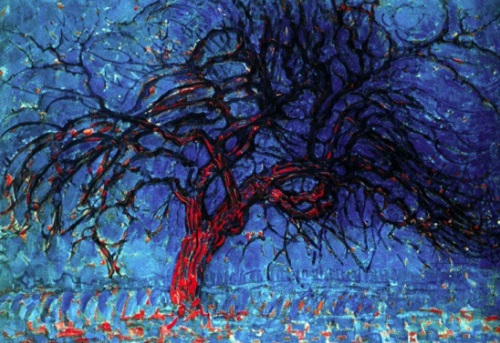
Why do artists love painting landscapes so much? Maybe it’s because they don’t move. Maybe it’s because there is so much variety. Or maybe it is because they are beautiful.
Piet Mondrian was an artist from the Netherlands, who painted a lot of trees.

Look at this wonderful painting from 1908. But why do artists paint the things that they paint? What made Mondrian want to paint a tree, of all things?
There are many reasons people make art, but perhaps the most obvious one is because of their foolish desire to attain beauty. People like to see beauty in the world, and since we have evolved a useful pair of opposable thumbs, why not have some fun and try to recreate that beauty through oils and pigment?
But why is the tree beautiful? Where is the beauty hidden? Is it in the shapes of its branches, or the colour of its wood - or maybe a combination of those things? That is the job of the artist - to find where that beauty is, and emphasise it through composition and colour.
Consider the painting above - we know that trees are not red, so why did Mondrian paint it so? The saturated blue tones in the background evoke the image of a dark evening, and the tree with its bright red appears to burst through the gloom of the night with fiery energy - KAPOW! Maybe this is what Mondrian saw when he looked at the tree - a living creature bringing life to an otherwise empty scene.

How about this tree, painted in 1911? Oh no! Where did the colours go? Look at all those funky shapes - the curves and sharp edges. Maybe Mondrian was seeing something else in this tree - seeing beyond the colours and focussing on the shapes made by the interacting branches, and the structures they seem to carve into the sky behind them.

Just one year later, and Mondrian’s vision of a tree has turned into this. Is this even a tree any more? What am I even looking at? I am so ENRAGED! This is BULLSHIT!
Or is it?
Maybe it was at this moment that Mondrian realised something exciting! Yes, there is plenty of beauty to appreciate in the tree, but would that beauty still exist were the tree not there? Is it the tree that holds those beautiful shapes and colours, or is it something beyond?

The year is 1916 and Mondrian has finally let go of any pretense. There is no tree - just structure and harmony. We are travelling alongside the artist on his never ending journey towards perfect BALANCE!
I bet you didn’t even realise it was upside down.
How can I know this painting is beautiful, if I can’t tell what it is? If I can’t even know if it is anything at all?
Isn’t it funny that throughout the thousands of years of classical art, it’s only in the last century or so that anyone had the idea of painting things that were not there? Why paint things in the real world when you can just skip all that, and dive straight into the patterns and shapes that make the real world beautiful in the first place! This is what we call abstraction - instead of painting the tree, we look for the part of the tree that made us want to paint it, and just paint that instead.
We never had this problem with music. Classical composers didn’t try to recreate the sounds of nature in their music - they made their own sounds and still found a way to pull on our heart strings.
In the world of folk art, abstraction has been happening for a long time!

Look at these traditional Sicilian tiles. They evoke that same floral sense of beauty, without a single flower in sight.
Even our caveman ancestors got the vibe.

Here is a cave painting discovered in California, painted thousands of years ago.

This is Mondrian’s final painting - titled ‘Victory Boogie Woogie’. He was living in New York and loved the funky new JAZZ sounds that were popular at the time. In the painting you can see the bustling streets and the syncopated jazz rhythms he loved to dance to. The art scene changes a lot from place to place and time to time, but it’s nice to see we all have something in common.
Some relic in our monkey brains makes us like these pretty shapes and colours. Ever since our ancestor monkeys climbed up trees for safety, these patterns in nature have provided us with comfort. We don’t need to climb the tree for safety any more, but a part of that history lives on in our monkey brain. So next time you see a lone tree, tap into that monkey part of your brain, and think to yourself ‘Ook Ook’.
